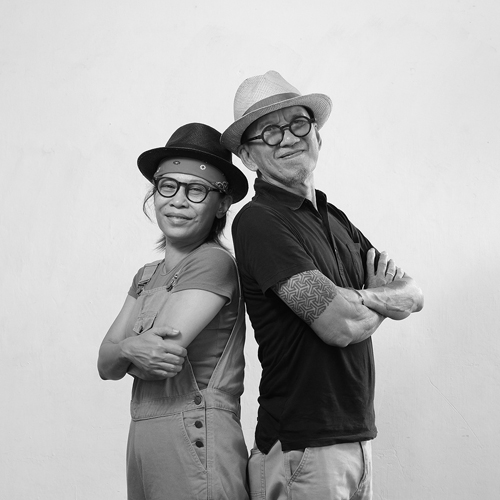
Agus Suwage (born in Purworejo, 1959) is an artist who completed his Graphic Design education at Faculty of Fine Arts and Design ITB, Bandung in 1986. At the start of his career, Suwage explored topics of social commentary. He also often explores media such as the use of asphalt and soil in his works. Meanwhile, Suwage's painting works are also mostly expressed on paper rather than canvas, which often depicts his self-portrait as the subject of the painting. Suwage's self-portrait works are not only an independent subject, but also exists side by side with other elements. Thus, Suwage's works can be seen as a combination of self-reflection and contradiction about the "self" itself. These self-portraits also place Suwage in two positions at once, namely as subject and object, expressing his attitude towards himself and illustrating that "self" will always change in the midst of the ever-changing social life.
Suwage has received awards from Phillip Morris Indonesia Art Award and Phillip Morris ASEAN Art Award. His first solo exhibition was held at Cemeti Art House, Yogyakarta in 1995, while his first overseas solo exhibition was held at H Block Gallery QUT, in Brisbane, Australia. In 1997, Suwage's works was exhibited in five exhibitions at once, four of which were held in India, Malaysia, Cuba and Japan. Several other exhibitions, including CYCLE No.2 and CYCLE No.3 (2013), The End Is Just Beginning Is The End, The Tyler Rollins Fine Art, New York, America (2011), and Pause/Re-Play, Bandung (2005). Recently, the exhibition of Agus Suwage: The Theater of Me, Museum MACAN (2022) displays his career journey in the world of fine arts in the last 30 years.
Titarubi (born in Bandung, 1968) completed Fine Arts Department, Faculty of Fine Arts and Design, ITB Bandung in 1997. Titarubi founded Indonesia Contemporary Art Network (iCAN) together with Enin Supriyanto in 2008. Titarubi's works touch on many humanitarian issues, especially in the history of national development. Regarding this matter, she once displayed two statues in the form of robes made from nutmegs plated with pure gold. This works describes how colonization initially worked to search for spices, one of which was nutmeg, which ultimately resulted in the rise of the nutmeg commodity until it exceeded its human value. This works was displayed in the Discourse of the Past exhibition (2014).
TItarubi first held her solo exhibition entitled Yang Kelak Retak, Stage Cafe and Pondok Indah Mall Jakarta (1995). Several other solo exhibitions, including Senyap, Salian Art, Bandung (2015), Discourse of the Past, Philo Art Space, Jakarta (2014), Burning Boundaries, Galerie Michael Janssen, Berlin (2013), commission work Surrounding David, National Museum of Singapore, Singapore (2008), Kisah Tanpa narasi, Cemeti Art House, Yogyakarta (2007), and Benih, Via-Via Cafe, Yogyakarta (2004). Titarubi's works has also been exhibited in various joint exhibitions in Asia and Europe, including the Singapore Biennale, ZKM Center for Art and Media (Karlsruhe, Germany), Museum and Art Gallery of the Northern Territory (Darwin, Australia), Busan Biennale Sculpture Project , and MACRO (Museo d'Arte Contemporanea in Rome, Italy).
Agus Suwage and Titarubi did a collaboration to present a complex installation work in a special building, a closed corridor filled with sound, tridimensional objects, images, seeds, plants and rice grains. This unified work, which combines various vehicles and living organisms, occupies a corridor 26 meters long, 11 meters wide and a ceiling height of between 3 and 6.3 meters. This corridor has 7 rooms of different sizes, presenting various configurations and messages from this pair of artists before ending in a stretch of various rice plants at the back. Being in this tunnel is experiencing a silence that is separate from the outside world. Corridors with rooms in them give a sense of depth to visitors.
Agus Suwage presents nine tridimensional works with various vehicles that emphasize the human ear objects. The earpiece installation is placed at the front of the hall and fills seven rooms in the corridor, taking the form of a pillar, tree, cupboard, wall, shelf, mirror and gabion. On the one hand, the object of the ear represents our social space which is very "tolerant" of noise and the disappearance of silence. On the other hand, only with the sense of hearing can we examine the bodily experience and experience silence.
Titarubi presents the results of her research which focused on rice plants. She explores local wisdom narratives and myths that accompany the sacredness of rice. In Sundanese culture there is a very old myth about Nyi Pohaci Sanghyang Asri who honored the rice plant. All plants that are useful for humans came from the body of the Goddess of Rice: coconut trees from the head, spices from the ears, flowers from the hair, fruits from the breasts, teak trees, sandalwood from the arms, and sugar palm and palm oil from the genital, bamboo grows from the thighs, tubers and cassava grow from the feet, and rice from the navel. This myth has been told for centuries through oral tradition. There is a tradition in Java that when farmers start harvesting rice, they recite prayers in a procession called "Mboyong Mbok Dewi Sri (Bringing the Goddess Sri Home)". It is a sign that the welfare of the farmers must return to their own homes. In this corridor, Tita presents various recordings of prayers accompanying rituals and various forms of puja literature that glorify the spirituality of the earth and the rice plant. The extinction of seeds, the loss of diversity means that our knowledge about the relationship of organisms is incomplete and the consequences of this cannot be predicted.
The collaboration between Agus Suwage and Titarubi on a commissioned work for ARTJOG this year occurred after their participation at the Singapore Biennale in Singapore, 2006.